
Navigating Europe’s 2025 Meat Market: From Classic Cuts to New Trends
Explore the 2025 meat market: from steak online and halal beef meat to pork vendors and meat companies offering beef, lamb, poultry, and goat products.
Across Europe, the meat industry in 2025 continues to evolve under shifting consumer preferences and supply conditions. From traditional favorites like beef and pork to growing interest in lamb, poultry, and alternative proteins, businesses need agility to stay competitive.
Whether you're a meat company, a meat supplier, or a steak house operator, understanding the complete picture—from meat markets to meat store trends and evolving meat products—is critical. Here’s a breakdown of what's shaping demand across the meat sector today.
1. European Meat Market Growth & Dynamics
The Europe meat market is expected to expand from around USD 389 billion in 2024 to over USD 563 billion by 2033, growing at a steady 4.4% CAGR. Growth is driven by rising demand for protein, online meat shopping, and evolving distribution models.
Within the sector, pork meat remains a powerhouse—accounting for about 38% of market share in 2024, while fresh meat continues to dominate product types, making up over 60% of sales.
2. Shifting Demand for Beef, Lamb, Chicken & Pork
Global forecasts reflect evolving consumer behavior:
Meat consumption overall is projected to rise by nearly 48 million tonnes by 2034, with per capita consumption increasing modestly.
Meanwhile, retail channels like steak online, boxed meat, and meat in store are gaining traction, showing growing demand for convenient, high-quality options.
3. Leading Meat Companies & Industry Players
Major players driving the global meat industry include:
Cargill, Tyson Foods, JBS S.A., and Marfrig — delivering everything from beef meat to poultry meat and specialty meat products.
In Europe specifically: Danish Crown (pork & beef), LDC Group (poultry), Vion Food Group, Tönnies, and Groupe Bigard stand out for scale and market reach.
These companies are modernizing supply chains, expanding exports, and adapting to evolving demands—including from halal meat butchers, butcher shops, and halal shops online.
4. External Factors & Emerging Trends
The EU’s reliance on imported animal feed, especially soy, makes meat prices vulnerable. Increasing interest in new meat alternatives—like plant-based or cultured meat—offers strategic inroads to price stability and sustainable practices.
Meanwhile, global geopolitics are reshaping trade. China’s recent imposition of anti-dumping duties on EU pork highlights fragility in established export flows.
5. What Businesses Should Do
If you’re looking to buy meat or pork meat in bulk—or to position yourself as a leading beef farm or meat manufacturer—platforms like Meat Borsa help you connect directly with meat companies across Europe.
Suppliers adapting to offer both bulk and value-added formats—like steak by price, farm steak, or pork and meat bundles—can tap into fast-changing buyer preferences.
Providers focusing on niche segments—like goatling meat, halal beef meat, or lamb meat—can stand out in specialty markets.
Final Thought
Europe’s meat landscape in 2025 blends tradition with disruption. Success means staying agile: whether you're a meat seller, a beef company, or a meat supplier focused on quality or niche products, tapping into emerging trends and diversifying your network will drive growth and resilience.
